Posts Tagged ‘rattan’
Sunday, March 12th, 2017
This large porcelain Chinese punch pot with blue & white floral decoration was made during the Qianlong period (1736-1795). It measures nearly 9 inches high and 11 inches from handle to spout.
In the mid-1700s, alcoholic punch, which consisted of spirits, water, sugar, nutmeg, and spices, was served in what looks like oversized teapots. I guess too much alcohol was added to an early batch, as whoever held this pot at the time was a bit tipsy and dropped it. After the handle shattered, it was taken to a tinker who made a bronze replacement. The raw metal was wrapped in wicker to protect one’s hands from the hot contents of the pot. Over the past 200 years or so since the repair was made, much of the wicker has fallen off, exposing the metal. I can only hope that the next person who fills this pot with hot punch remains sober and keeps a tight grasp on it.

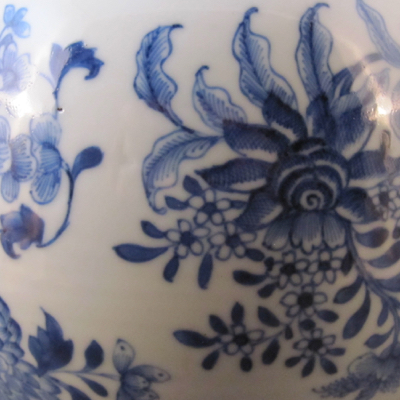

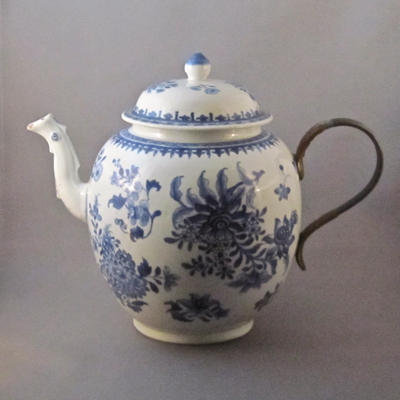
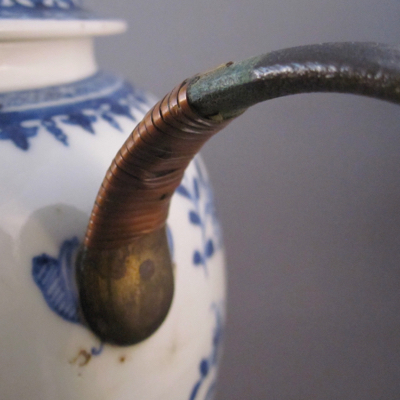
This punch pot of similar form shows with the original handle on mine most likely looked like.
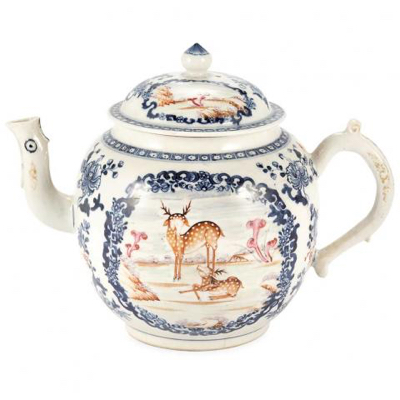
Photo courtesy of Doyle
Tags:blue & white, Chinese, metal handle, Qianlong, rattan
Posted in punch pot | 1 Comment »
Sunday, September 25th, 2016
Early in my collecting days I purchased a small pottery cream jug with blue & white transfer decoration and a wonderful wicker replacement handle. I had not seen a repair quite like it before, woven, I believe, by a basket maker. Flash forward about 20 years when I was notified by one of my favorite dealers in the UK who offered me another jug with a similar woven handle. The photo he sent did not show the scale, so I had no idea what size the jug was. When an oversized parcel arrived a couple of weeks later, I unpacked what turned out to be a HUGE jug.
This Dutch shape pottery jug with blue and white transfer decoration and woven rattan replacement handle was made in England in the first quarter of the 1800s. Measuring 9.25 inches high and 12.5 inches wide from lip to handle, it is marked “Lasso” on the underside. It must have been much loved over the past 200 years, as is evident by the unusual replacement handle and large hole worn away on the bottom. Although unable to hold liquids today, this impressive jug and ultimate survivor still commands respect merely by sitting quietly on a shelf in my home.
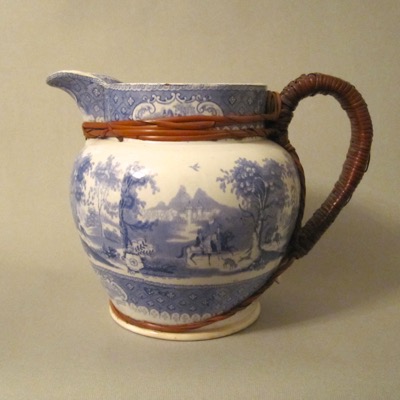
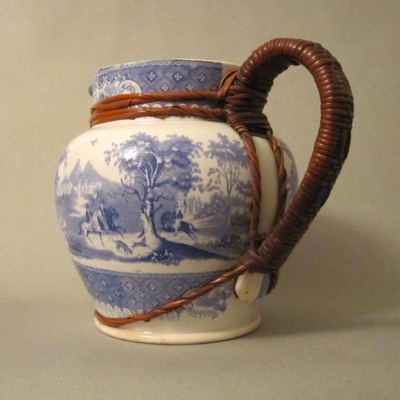
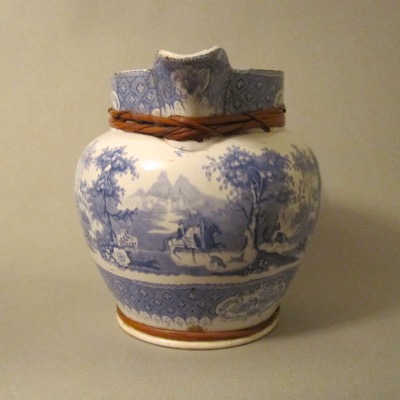
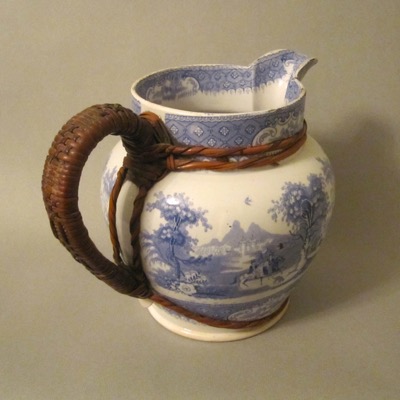
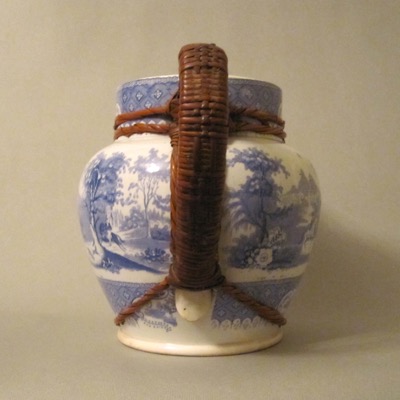
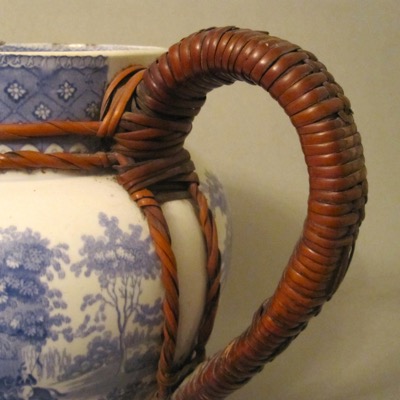
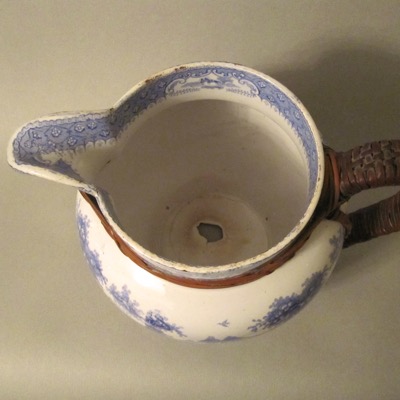
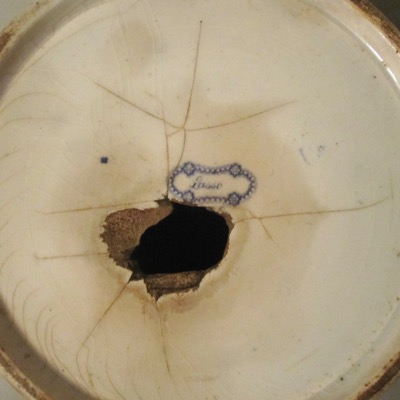
This jug with similar form and decoration shows what the original handle on my jug may have looked like.

Photo courtesy of Applecross Antiques
Tags:blue & white, English, pottery, rattan, transferware
Posted in jug | 1 Comment »
Sunday, July 10th, 2016
This cylindrical form porcelain coffee can (or coffee cup, outside of the UK) is decorated with cobalt blue underglaze decoration and has brown glaze along the rim. It was made in China during the Qianlong period (1711-1799) for export most likely to North America and Europe. It measures 2.5 inches tall.
Well over one hundred years ago, this small cup slipped from someone’s grasp, resulting in its handle snapping off. Rather than being tossed out, the precious cup was taken to a “china mender” who fashioned a sturdy iron replacement handle wrapped in rattan. The woven rattan acts as an insulant from the hot contents and allows for a tighter grip.




This coffee can with the same form and similar decoration shows what the original handle on mine might have looked like.

Photo courtesy of Etsy
Tags:blue & white, Chinese, metal handle, rattan
Posted in cup/saucer | 1 Comment »
Saturday, May 28th, 2016
This elongated Baroque serpentine form silver shape sauce boat was made in China during the Qianlong period (1736-1796). It is made of porcelain and decorated in the Famille Rose palette, with hand painted flowers, ducks, and garden stools in pink, green, blue, and white enamels with gilt highlights. It measures 9-3/4 inches long by 3-5/8 inches high.
Well over 150 years ago when the original simple loop handle snapped off, a “china mender” fashioned a replacement handle, which was riveted to the body. To help insulate the metal from the hot contents, rattan was wrapped and woven around the handle. This would have been one of a pair of matching sauce boats and was a part of a large dinner service. I wonder if it was separated from its mate and other “perfect” serving pieces, as was often the case.
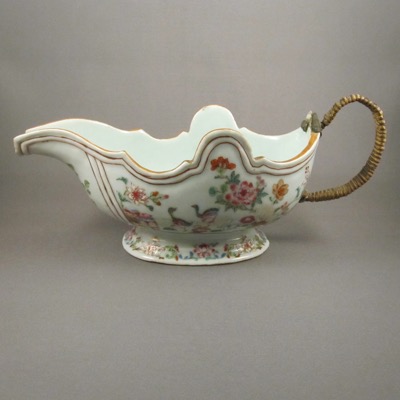





The original handle on this sauce boat, with identical form and similar decoration, gives you an idea of what the handle on my sauce boat would have looked like.
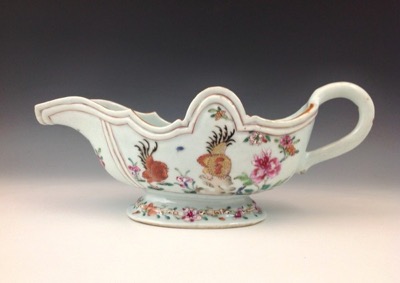
Photo courtesy of Online Galleries
Tags:bronze, Chinese, metal handle, porcelain, rattan
Posted in sauce boat | No Comments »
Saturday, April 23rd, 2016
This porcelain baluster form cream jug with sparrow beak spout has floral decoration painted with polychrome enamels in the Famille Rose palette. It was made in China, circa 1760, and measures 4.5 inches tall.
After the original porcelain handle broke off, a rattan-wrapped bronze replacement handle was added. The missing patch of woven rattan reveals a bent section of bamboo just under the handle which was added to help cushion the bare metal. The tactile ridges in the rattan also make the handle easier to grip.





This jug of similar form shows what the original handle and lid might have looked like on mine.

Photo courtesy of De Franse Lelie
Tags:bronze, Chinese, metal handle, porcelain, rattan
Posted in jug | No Comments »
Sunday, August 30th, 2015
This globular form porcelain teapot was made in China in the mid-1700s for export to Europe and North America. It measures 6 inches high and 9 inches from handle to spout and is decorated in the famille rose palette with a coral scale ground and puce flowers.
Soon after the teapot dropped and the handle shattered, it was taken to a tinker, jeweler or metalsmith who fashioned this nicely made metal replacement handle. To help insulate delicate hands from the hot contents, the handle was encased in woven rattan. I have dozens of examples of woven rattan handles and have noticed distinctly different patterns among them. I am hoping to one day match up the woven handle patterns to specific makers, although I know that is a long shot. As an added bonus, a small section of missing rattan has been patched using string, no doubt at a later date, a true case of a make-do making-do.


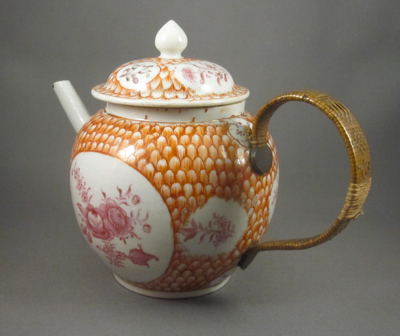
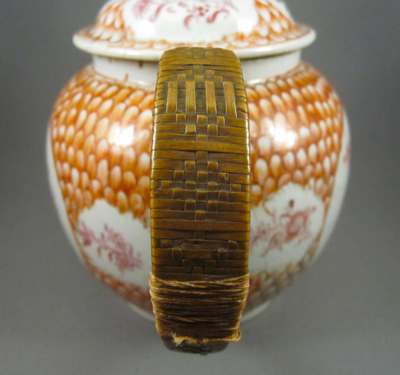
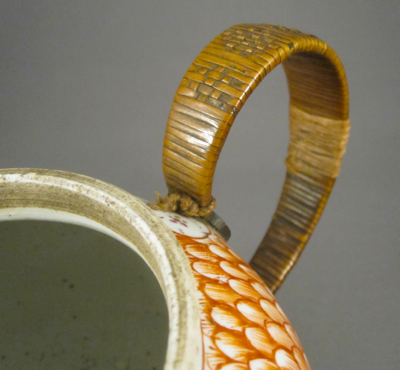
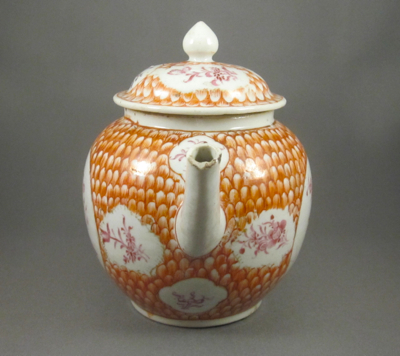
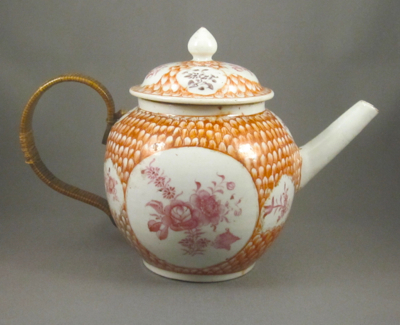
This teapot with similar form and decoration shows what the original loop handle on my teapot looked like before it took a tumble.
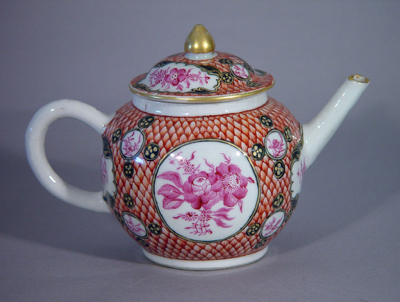
Photo courtesy of Earle Vandekar of Knightsbridge
Tags:Chinese, globular, metal handle, porcelain, rattan
Posted in teapot | No Comments »
Saturday, April 4th, 2015
I own a classic book about collecting antique English household pottery, “If these Pots Could Talk” by Ivor Noel Hume. Regarding the early usage of this particular pot, I’d rather not hear what it has to say. This Chinese export porcelain chamber pot with cover dates from the Qianlong period (1735-1796) and measures 5-1/2″ high to the top of the lid and is 9-1/2″ wide to the end of the handle. It is hand decorated in the Famille Rose palette with panels of birds and flowers with gilt highlights.
The thought of about how this pot lost its original handle is something I’d rather not dwell on but I just hope it was empty when it broke. As this was an expensive and necessary asset to the household, it was not thrown out but immediately repaired and put back in to use. Most likely it was taken to a china mender who made a sturdy metal replacement handle, then covered it in woven wicker to aid against further slippage.
I remember a certain customer in my parents antiques shop years ago who purchased a large Victorian ceramic slop bucket from a bedroom chamber set. Knowing what it was, she proceeded to boast that she intended to use it as a soup tureen at an upcoming dinner party she was throwing for the kids where she had already talked to the http://www.jumpersjungle.com/santa-fe-springs/, team from kids birthday parties Santa Fe Springs to help her. If that pot could talk, I hope it would have warned the dinner guests not to eat the chowder!




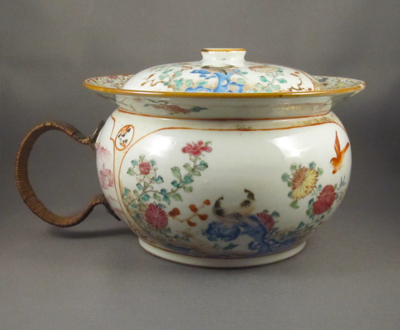

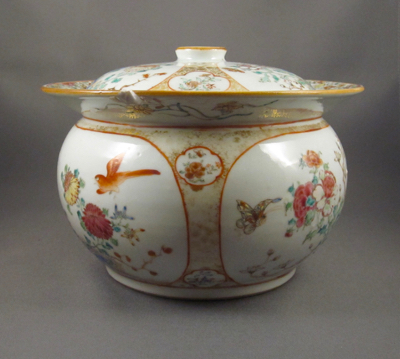
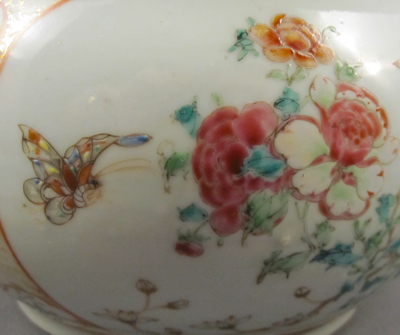
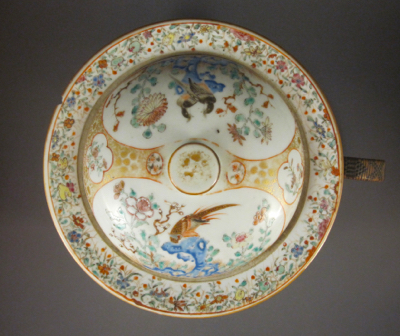
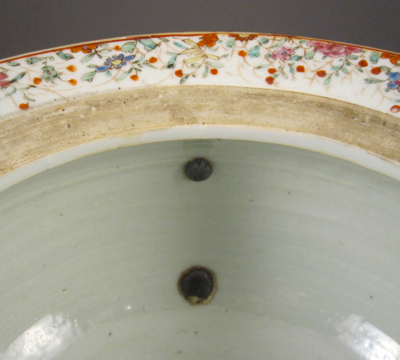
This identical example shows what the original handle on mine looked like before it broke off. Notice the multiple chips along the rim. I’m guessing that many chamber pots went bump in the night.

Photo courtesy of Andrew Dando
Tags:Chinese, metal handle, porcelain, Qianlong, rattan
Posted in pot/jar | 2 Comments »
Sunday, August 3rd, 2014
This Chinese baluster shaped porcelain jug, with molded spout in the manner of European silver, has hand painted underglaze cobalt blue Nanking decoration of houses, trees and birds. It dates from the middle of the 18th century and stands nearly 8″ tall.
Over 100 years ago when the original reeded strap handle broke off, an unusual split form metal replacement handle was added. A clever tinker reinterpreted the original handle design by forging a bronze loop handle into four extensions and adding small discs, which were riveted to the leaf terminals. The remains of an intricately woven rattan sheath are found on about one third of the handle. Most curiously, there is an engraved signature on the underside, difficult to decipher, which may be the name of the china mender or of a previous owner. If anyone knows more about this marking, please let me know.







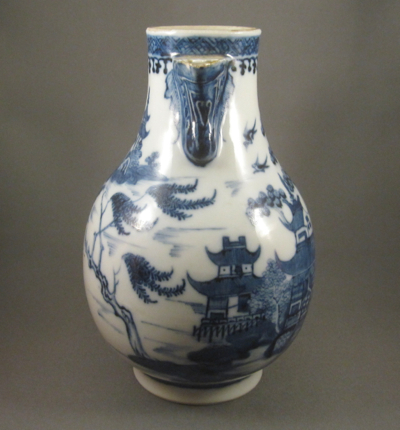

This jug with similar form and decoration shows what the original handle on my jug may have looked like.

Photo courtesy of eBay
Tags:blue & white, bronze, Chinese, metal handle, porcelain, rattan
Posted in jug | 2 Comments »
Saturday, July 5th, 2014
In honor of Independence Day I am pleased to share with you a Chinese porcelain mug with a fireworks theme, made for export to North America and Europe during the Qianlong period (1736-1795). It stands 4-3/4″ high and is decorated in the Mandarin style with cloud-shaped cartouches executed in famille rose enamels, and containing floral sprigs and a family tableau depicting a child lighting fireworks.
I wouldn’t be surprised if during the first organized 4th of July celebration in 1777, a raucous party involving the lighting of fireworks forced this mug to fly off a table and crash to the ground, causing its handle to shatter and the bottom to fall off. Rather than throw out the expensive and cherished mug, it was brought to a local tinker who fashioned a sturdy brass replacement handle. To help insulate the handle from its hot contents, it was wrapped in decoratively woven rattan. The bottom was reattached to the body using five large brass staples with a bond so tight it could hold liquid without leaking. As china menders typically did not sign their work, there is no way to know who was responsible for this repair, but I imagine they each had their own signature style in weaving the rattan so that they could distinguish their work from each other.


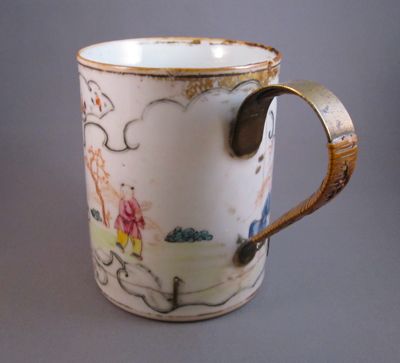

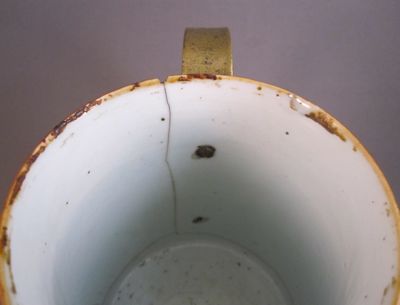


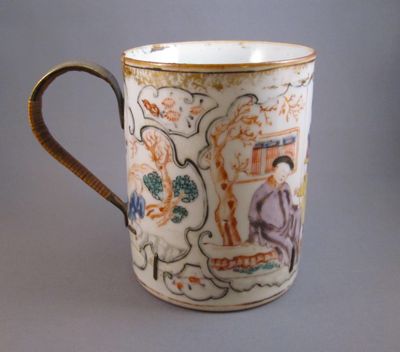

These mugs of similar form show what the original handle on my mug might have looked like.
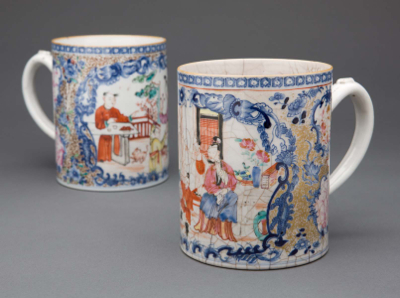
Photo courtesy of Mount Vernon’s Mystery Midden
Tags:Chinese, metal handle, porcelain, rattan, staples/rivets
Posted in mug/tankard | 5 Comments »
Sunday, June 29th, 2014
This wee globular form teapot was made in China during the Kangxi period (1661 – 1722) and measures just 2-1/2″ high and 4-1/4″ from handle to spout. It has Famille Vert decoration of floral bouquets tied with ribbon in blue underglaze enamel, iron red and green washes, and gilt highlights. The domed cover, decorated with plum blossoms, has a tiny vent hole, just as its full-size counterpart would have. I believe that this was part of a larger tea set purchased for a child from a wealthy family, as only the upper class were able to afford imported Chinese porcelain.
Without seeing the coin to show the lilliputian size of the teapot, I doubt you would have guessed that this is a miniature. The exquisitely crafted metal replacement spout and rattan-covered bronze handle are superior to the more standard repairs seen on most other miniatures. It seems that someone truly appreciated the stellar repair work, as is evident by the teeth marks at the end of the spout. Perhaps this was just a child’s way of saying “This new spout tastes better than the old one. Thanks, and job well done!”

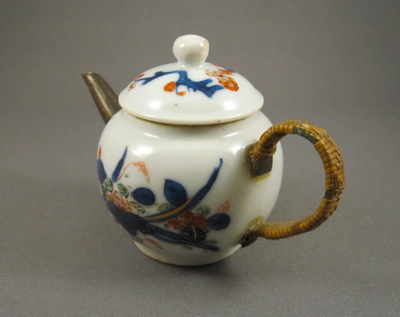
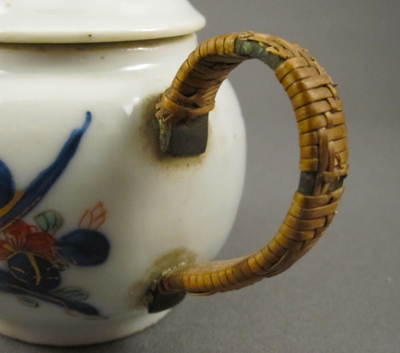
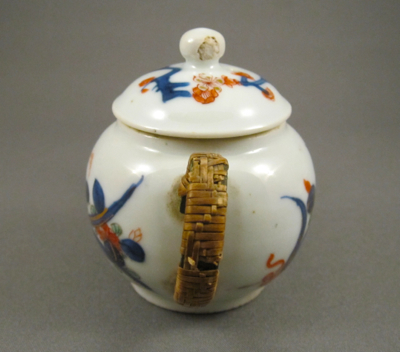
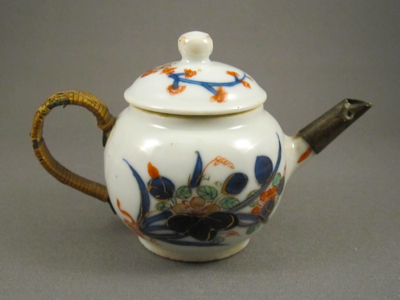
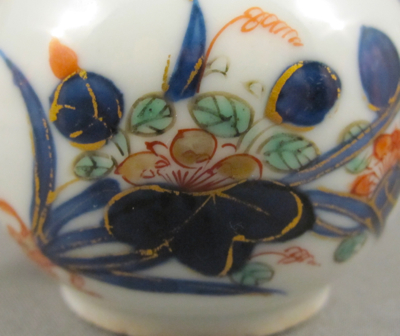

This nearly identical miniature still has its original handle and spout, but I think my teapot is the more interesting one of the pair.

Photo courtesy of eBay
Tags:Chinese, metal handle, metal spout, miniature, rattan, silver
Posted in teapot | 3 Comments »















































































